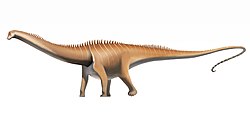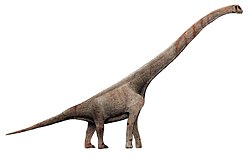| Plateosauravus Temporal range: Norian ~ | |
|---|---|
 | |
| Humerus | |
| Scientific classification | |
| Domain: | Eukaryota |
| Kingdom: | Animalia |
| Phylum: | Chordata |
| Clade: | Dinosauria |
| Clade: | Saurischia |
| Clade: | † Sauropodomorpha |
| Clade: | † Plateosauria |
| Genus: | † Plateosauravus von Huene 1932 |
| Species: | †P. cullingworthi |
| Binomial name | |
| †Plateosauravus cullingworthi (Sidney Haughton 1924 [originally Plateosaurus ]) | |
Plateosauravus ("grandfather of Plateosaurus ") is a basal plateosaurian of uncertain affinities from the Late Triassic Elliot Formation of South Africa.
Sidney Haughton named Plateosaurus cullingworthi in 1924 from a partial skeleton, [1] type specimen SAM 3341, 3345, 3347, 3350–51, 3603, 3607. The specific name honoured collector T.L. Cullingworth. Friedrich von Huene reassessed it in 1932 as belonging to a new genus, which he named Plateosauravus. [2] Jacques van Heerden reassigned it to Euskelosaurus in 1979, and this has been how it was usually considered. [3] However, recent study indicates that Euskelosaurus is based on undiagnostic material and thus a nomen dubium ; in his series of sauropodomorph and basal sauropod papers, Adam Yates has recommended no longer using Euskelosaurus and has suggested the use of Plateosauravus instead. [4] [5] [6] [ original research? ]
More than a dozen additional partial skeletons have been found in the Kruger National Park after a discovery by game warden Adriaan Louw on 27 March 1995. These include juvenile individuals. [7]











